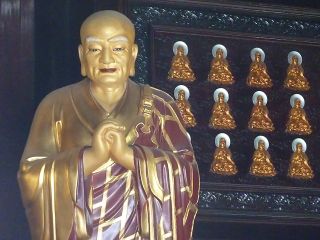The bustling cosmopolitan landscape of Shanghai can leave visitors with a somewhat distorted view of China’s rapid modernization. To see the developing economy's true character you must head into the interior. Here its provincial towns and cities reveal the somewhat schizophrenic nature of rapid development. Xian is one such destination.
Xian was one of China’s earliest national capitals. For more than 1500 years imperial rulers commanded the nation from within its fortified walls. It marked the eastern end of the Silk Road’s trade with Europe. In 1974, the city was catapulted in the global spotlight by the discovery of a vast terracotta army buried under local farmland. Since then the city has undergone several waves of modern commercial development.
Xian was one of China’s earliest national capitals. For more than 1500 years imperial rulers commanded the nation from within its fortified walls. It marked the eastern end of the Silk Road’s trade with Europe. In 1974, the city was catapulted in the global spotlight by the discovery of a vast terracotta army buried under local farmland. Since then the city has undergone several waves of modern commercial development.
These early facilities, somewhat crude by Western standards, have since been superseded by more modern, world-class infrastructure. As a result, visitors are assaulted by layers of urban development, some bold and imaginative, much dull, grey and drab. The layers begin with those of an ancient capital, followed by a decline into a provincial backwater, the subsequent addition of stark communist forms and then finally back into waves of rapid, modern development.
A great example of this spectacle was the Grand Park Hotel where my parents and I stayed. Built in 1992, it was once the city’s first five-star hotel. Today, the building looks incredibly dated; an obviously clunky first attempt at creating world-standard accommodation. Across the road stands the south gate of the ancient city's massive defensive walls. Between these two venues sits the shiny glass entrance of a recently openly underground metro station.
We arrived in Xian shortly after lunch on our third day in China. I last visited the city in 2003. At the time the airport proudly boasted a new expansive glass terminal. This time, we arrived at an even larger, far more cavernous terminal that dwarfs its predecessor. Our guide later told us the building had been open less than a month.
We arrived in Xian shortly after lunch on our third day in China. I last visited the city in 2003. At the time the airport proudly boasted a new expansive glass terminal. This time, we arrived at an even larger, far more cavernous terminal that dwarfs its predecessor. Our guide later told us the building had been open less than a month.
This is typical of China. A building constructed barely a decade ago rapidly becomes inadequate and a larger, more glamorous replacement is built. Since I first began flying into Beijing in 1998, this city’s airport has operated three progressively larger terminal buildings. Incredibly, the city is now building an entirely new airport having decided the current location is too small.
We spent our first afternoon in Xian visiting Big Wild Goose Pagoda. This spectacular seven-tier, tower sits in the grounds of the city’s most famous Buddhist temple. The pagoda was built in AD 652 to store religious scrolls translated by Xuan Zang, a travelling monk attributed with bringing Buddhism from India to China. A five metre high statue of the monk greets visitors at its main entrance. Remarkably, the 64-metre high pagoda has survived several major earthquakes despite being constructed of nothing more substantial than rammed earth bricks.
Its main hall shelters a large bronze Buddha, while adjacent halls house several popular shrines. Perhaps the enigmatic of these is a side hall where row upon row of gold mini Buddha statues line the walls. They owe their presence to businessmen from around the nation who’ve purchased them as an offering designed to bring them financial fortune.From the pagoda, we made our way to dinner. We’d booked tickets for a colourful cultural show based loosely on events from the Tang Dynasty. Our tickets included a generous meal of assorted dumplings, brought to our table in a teetering stack of bamboo steamers. Dumplings are a popular local delicacy. The Tang Dynasty show was quite an experience. For more than an hour, we were entertained by talented young musicians playing all manner of ancient Chinese musical instruments, interspersed with lively traditionally costumed dancers. It was the perfect end to our first day in Xian.

















No comments:
Post a Comment